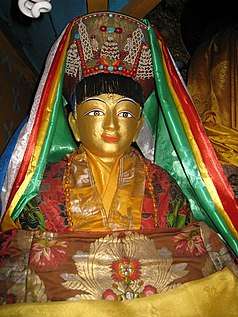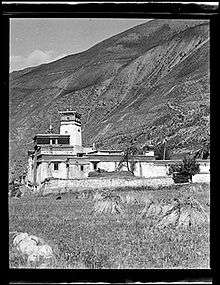Milarepa
Jetsun Milarepa (Tibetan: རྗེ་བཙུན་མི་ལ་རས་པ, Wylie: rje btsun mi la ras pa , 1028/40–1111/23)[1] was a Tibetan siddha, who famously was a murderer as a young man before turning to Buddhism and becoming a highly accomplished Buddhist disciple. He is generally considered one of Tibet's most famous yogis and spiritual poets, whose teachings are known among several schools of Tibetan Buddhism. He was a student of Marpa Lotsawa, and a major figure in the history of the Kagyu school of Tibetan Buddhism.[1] He is also famous for the feat of climbing Mount Kailash.

Biography
The Life of Milarepa
| Part of a series on |
| Tibetan Buddhism |
|---|
 |
|
|
|
Practices and attainment |
|
Institutional roles |
|
History and overview |

Milarepa's life-story is famous in the Tibetan culture, and retold many times. The best-known biography, The Life of Milarepa, written by Tsangnyön Heruka (1452–1507) in the fifteenth century and drawing from older biographies, is still very popular.[1][2][3] Most of the present-day stories on Milarepa come from this single source, with oral lineage predominating this as well as relics including his bear skinned coat.[3] While "very little [is known] about him as a historical person at all," Milarepa is venerated by all Tibetan schools "as an exemplar of religious dedication and mastery," and his lifestory established the lineage of the Kagyu sect and its key figures.[3]
According to The Life of Milarepa, Milarepa was born in western Tibet to a prosperous family.[1] When his father died, his family was deprived of their wealth by his aunt and uncle. At his mother's request, Milarepa left home and studied sorcery to take revenge, killing many people.[1] Later he felt sorrow about his deeds, and became student of Marpa the Translator. Before Marpa would teach Milarepa, he had him undergo abuse and trials, such as letting him build and then demolish three towers in turn. Milarepa was asked to build one final multi-story tower by Marpa at Lhodrag, which still stands.[4] Eventually, Marpa accepted him, explaining that the trials were a means to purify Milarepa's negative karma.[1] Marpa transmitted Tantric initiations and instructions to Milarepa, including tummo ("yogic heat"), the "aural transmissions" (Wylie: snyan rgyud ), and mahamudra.[3] Marpa told Milarepa to practice solitary meditation in caves and mountain retreats, which, according to the biography, after many years of practice resulted in "a deep experiential realization about the true nature of reality."In some other sources, it is said that Milarepa and Marpa both came to India to seek one most important thing for ultimate realisation from Marpa's guru ,but even he didn't know about it. Later on he tried for many years and finally attained enlightenment. Thereafter he lived as a fully realized yogi, and eventually even forgave his aunt, who caused the misfortune of his family.[3]
According to Lopez, The Life of Milarepa represents "Buddhism as it was understood and practiced in Tibet in the fifteenth century, projected back in time,"[2] and contains "many of the key terms and doctrines of Buddhism."[2] Tsangnyön Heruka did his best to establish a lineage of teachers which connects the Kagyu tradition with the Indian siddha tradition, portraying Marpa as a student of Naropa, though Naropa had already died when Marpa went to India.[2]
Lopez notes that Tsangnyön Heruka used stylistic elements from the biography of Gautama Buddha to portray Milarepa effectively as a Tibetan Buddha, "born and enlightened in Tibet, without going to India or receiving the direct instructions of an Indian master."[2] The lifestory of Milarepa portrays "the rapid method of the Tantric path," in which liberation is gained in one lifetime. It describes how Milarepa practiced the generation stage and completion stage, to achieve mahamudra, "spontaneous realization of the most profound nature of mind."[2] Yet, in his instructions to his Tibetan audiences, Milarepa refers to the basic Buddhist teachings of "impermanence, the sufferings of saṃsāra, the certainty of death and the uncertainty of its arrival, the frightful rebirth that is the direct result of our benighted deeds." But, his own life also is an example that even a murderer can transform into a Buddha.[2] Lopez further notes that The Life of Milarepa portrays two parallel worlds, a profane world and a sacred world, which are ultimately one, showing that the world itself is sacred.[2]
The Hundred Thousand Songs of Milarepa
The acclaimed spiritual poetry of Milarepa is known of as The Hundred Thousand Songs. Previous biographies of Milarepa were enlarged with religious poetry and song cycles, which doubled the volume of biographical information. In 2017, Tsangnyön Heruka re-published these songs in a separate volume entitled The Hundred Thousand Songs of Milarepa, which also summarizes the various song cycles in chapter eleven of The Life of Milarepa.[3]
Historical context
Milarepa lived during the so-called second dissemination of Buddhism in Tibet (10th–12th century), when Buddhism was re-introduced. Three pivotal figures in this Tibetan Renaissance were Rinchen Zangpo (958–1055), who translated sutras, tantras and commentaries; Atiśa (982–1054), whose student Dromtön founded the Kadam school of Tibetan Buddhism; and Marpa the Translator, the teacher of Milarepa, and himself regarded as student of Naropa. Marpa introduced tantric texts and oral instructions from the Bengali siddha tradition into Tibet,[2] and Marpa's purported connection with Naropa established the lineage of the Kagyu school, thereby reaching back to the Buddha himself.[2][3]
Gallery
%2C_Late_19th-early_20th_Century%2C_Dhodeydrag_Gonpa%2C_Thimphu%2C_Bhutan.jpg) Bhutanese painted thanka of Milarepa (1052-1135), Late 19th-early 20th century, Dhodeydrag Gonpa, Thimphu, Bhutan
Bhutanese painted thanka of Milarepa (1052-1135), Late 19th-early 20th century, Dhodeydrag Gonpa, Thimphu, Bhutan Milarepa, Tempera on cotton, 21x30 cm, 2008 Otgonbayar Ershuu
Milarepa, Tempera on cotton, 21x30 cm, 2008 Otgonbayar Ershuu_LACMA_M.82.165.2.jpg) Tibetan or Nepalese painted thanka of Milarepa, 19th century, mineral pigments and gold on cotton clothes of Nepal.
Tibetan or Nepalese painted thanka of Milarepa, 19th century, mineral pigments and gold on cotton clothes of Nepal.
References
- Quintman 2004, p. 536.
- Lopez 2010.
- Quintman 2010.
- prm.ox.ac.uk: Sekhar Gutog monastery in Lhodrag near Bhutan
Sources
- Lopez, Donald S. Jr (2010), "Introduction", Tsangnyön Heruka. The Life of Milarepa, Penguin Books
- Quintman, Andrew (2004), "MI LA RAS PA (MILAREPA)", in Buswell, Robert E. (ed.), Encyclopedia of Buddhism, MacMillan
- Quintman, Andrew (2010), "Translator's Introduction", Tsangnyön Heruka. The Life of Milarepa, Penguin Books
Further reading
- Biography
- The Life of Milarepa, translated by Lobsang P. Lhalungpa, Book Faith India, 1997, ISBN 81-7303-046-4
- The Life of Milarepa, translated by Andrew Quintman, Penguin Classics, 2010, ISBN 978-0-14-310622-7
- The Yogin and the Madman: Reading the Biographical Corpus of Tibet's Great Saint Milarepa, by Andrew Quintman. New York: Columbia University Press, 2013. ISBN 978-0-231-16415-3
- Songs of Milarepa
- The Hundred Thousand Songs of Milarepa: A New Translation,Tsangnyön Heruka; under the guidance of Dzogchen Ponlop Rinpoche, translated by Christopher Stagg of the Nitartha Translation Network. Boulder, Shambhala, 2017. ISBN 9781559394482 OCLC 946987421
- Milarepa, The Hundred Thousand Songs of Milarepa, translated by Garma C.C. Chang, City Lights Books, 1999, ISBN 1-57062-476-3
External links
| Wikiquote has quotations related to: Milarepa |
- A Reader's Guide to Milarepa
- Biography on Kagyu website
- The sixty songs of Milarepa
- Text, The Essential Songs of Milarepa in English
- Inviting the demon. (Milarepa, Tibetan Buddhism)(The Shadowissue) Judith Simmer-Brown, Parabola Vol.22 No.2 (Summer 1997) pp. 12–18
- Gallery of Milarepa Thangkas by Dharmapala Thangka Centre
- Original Tibetan text of the biography of Milarepa at the Internet Archive
- Bronze sculpture of Yogi Milarepa at the University of Michigan Museum of Art
| Preceded by Marpa Lotsawa |
Kagyu school | Succeeded by Gampopa |